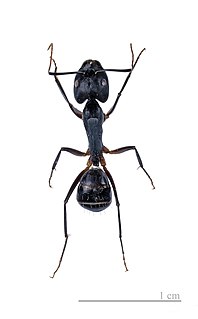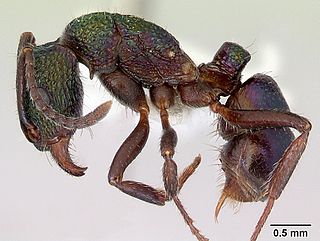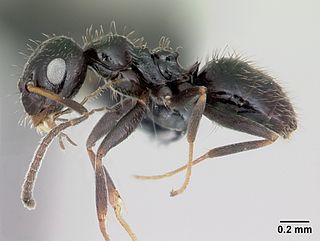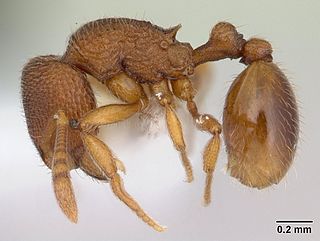
The Formicinae are a subfamily within the Formicidae containing ants of moderate evolutionary development.

Ponerinae is a subfamily of ants in the Poneromorph subfamilies group, with about 1,600 species in 47 extant genera, including Dinoponera gigantea - one of the world's largest species of ant. Mated workers have replaced the queen as the functional egg-layers in several species of ponerine ants. In such queenless species, the reproductive status of workers can only be determined through ovarian dissections.

Messor is a myrmicine genus of ants with more than 100 species, all of which are harvester ants; the generic name comes from the Roman god of crops and harvest, Messor. The subterranean colonies tend to be found in open fields and near roadsides, openings are directly to the surface. The genus Vessomessor was recently combined with Messor, adding eight more species.

Dolichoderinae is a subfamily of ants, which includes species such as the Argentine ant, the erratic ant, the odorous house ant, and the cone ant. The subfamily presents a great diversity of species throughout the world, distributed in different biogeographic regions, from the Palearctic, Nearctic, Afrotropical region and Malaysia, to the Middle East, Australian, and Neotropical regions.

Aphaenogaster is a genus of myrmicine ants. About 200 species have been described, including 18 fossil species. They occur worldwide except in South America south of Colombia, Sub-Saharan Africa, and Antarctica.

Myrmicaria is an ant genus within the subfamily Myrmicinae.

Myrmicocrypta is a Neotropical genus of fungus-growing ants in the subfamily Myrmicinae. The genus is known from Mexico to Argentina. Their colonies are generally small, consisting of fewer than 200 individuals.

Rhytidoponera is a large genus of ants in the subfamily Ectatomminae. The genus is known from Australia and Melanesia, with New Caledonia as the most eastern limit.

Dolichoderus is a genus of ants found worldwide.

Typhlomyrmex is a genus of ants in the subfamily Ectatomminae and the sole member of the tribe Typhlomyrmecini. Known from the Neotropics, the genus has a wide distribution. Some species are restricted in range, while for example Typhlomyrmex rogenhoferi is known from southern Mexico to northern Argentina. Little is known about their biology.

Cerapachys is a genus of ants in the subfamily Dorylinae. Species are mainly myrmecophagous ants which raid the nests of other ants for prey. The genus is distributed widely throughout the tropical and subtropical regions of the world, with the majority of species known from the Indo-Australian region.

Terataner is an African genus of arboreal ants in the subfamily Myrmicinae.

Lepisiota is an Old World genus of ants in the subfamily Formicinae. They nest in rotten wood, in standing trees or in the ground, generally in less forested areas.

Paraparatrechina is a genus of small ants in the subfamily Formicinae. The genus contains 31 species distributed in the tropics of Africa, Asia and Australia.

Ocymyrmex is an African genus of ants in the subfamily Myrmicinae, also commonly known as hotrod ants.

Rogeria is a genus of ant in the subfamily Myrmicinae. The genus is known from the Americas, Pacific, and Caribbean. Little is known about their biology.

Notostigma carazzii is a species of ant belonging to the genus Notostigma. The ant was first described by Emery in 1895. The species is endemic to Australia. Specimens are mainly found in the state of Queensland, and foraging workers are solitarily and nocturnal.




















